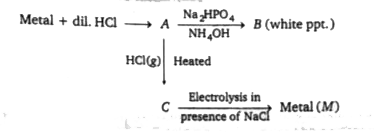Synergic bonds in organo – metallic compounds [M(CO4] leads to :
Shortening of M - CO bond
Lengthening of M - CO bond
No effect
None of these
The correct Answer is:A
To solve the question regarding the effect of synergic bonds in organometallic compounds like (M(CO)4), we will follow these steps:
Step 1: Understand Organometallic Compounds
Organometallic compounds are defined as compounds that contain a bond between a metal and a carbon atom. In this case, we are looking at a compound where the metal (M) is bonded to four carbonyl (CO) groups.
Hint: Remember that organometallic compounds involve a direct bond between metal and carbon.
Step 2: Define Synergic Bonding
Synergic bonding refers to a type of bonding where there is both a donation of electrons from the ligand (in this case, the carbonyl group) to the metal (forming a sigma bond) and a back-donation of electrons from the filled d-orbitals of the metal to the empty pi* (pi star) orbitals of the carbonyl group.
Hint: Focus on the concept of electron donation and back-donation in the bonding process.
Step 3: Analyze the Bonding in (M(CO)4)
In (M(CO)4), each carbonyl group (CO) acts as a ligand. The carbonyl group donates electrons to the metal, forming a sigma bond. Simultaneously, the metal donates electrons from its filled d-orbitals to the empty pi* orbitals of the carbonyl, creating a synergic bond.
Hint: Consider how the interaction between the metal and carbonyl groups enhances the overall bonding.
Step 4: Determine the Effect on Bond Length
Due to the synergic bonding, the bond between the metal and carbon (M-C) acquires a double bond character. This is because the back-donation from the metal to the carbonyl increases the effective bond order between the metal and carbon.
Hint: Recall that increased bond order typically results in shorter bond lengths.
Step 5: Conclusion on Bond Length
Since the M-C bond transitions from having single bond character to having double bond character due to the synergic bonding, the bond length decreases. Therefore, we conclude that the synergic bonding leads to the shortening of the M-C bond in (M(CO)4).
Hint: Remember that single bonds are longer than double bonds, which is key to understanding the effect on bond length.
Final Answer
The synergic bonds in organometallic compounds (M(CO)4) lead to the shortening of the M-C bond.
Correct Option: Shortening of MCO bond.
Organometallic compounds are defined as compounds that contain a bond between a metal and a carbon atom. In this case, we are looking at a compound where the metal (M) is bonded to four carbonyl (CO) groups.
Synergic bonding refers to a type of bonding where there is both a donation of electrons from the ligand (in this case, the carbonyl group) to the metal (forming a sigma bond) and a back-donation of electrons from the filled d-orbitals of the metal to the empty pi* (pi star) orbitals of the carbonyl group.
In (M(CO)4), each carbonyl group (CO) acts as a ligand. The carbonyl group donates electrons to the metal, forming a sigma bond. Simultaneously, the metal donates electrons from its filled d-orbitals to the empty pi* orbitals of the carbonyl, creating a synergic bond.
Due to the synergic bonding, the bond between the metal and carbon (M-C) acquires a double bond character. This is because the back-donation from the metal to the carbonyl increases the effective bond order between the metal and carbon.
Since the M-C bond transitions from having single bond character to having double bond character due to the synergic bonding, the bond length decreases. Therefore, we conclude that the synergic bonding leads to the shortening of the M-C bond in (M(CO)4).
The synergic bonds in organometallic compounds (M(CO)4) lead to the shortening of the M-C bond.
Topper's Solved these Questions
Similar Questions
Organo mercury compounds are
View SolutionLigands are broadly classified into two classes classical and non-classical ligands, depending on their donor annd acceptor ability. Classical ligands form classical complexes while non-classical ligands form non-classical complex. Bonding mechanism in non-classical is called synergic bonding.
Q. In compound [M(CO)n]z, the correct match for highest 'M-C' bond length for given M, n and z respectively:View SolutionLigands are broadly classified into two classes classical and non-classical ligands, depending on their donor annd acceptor ability. Classical ligands form classical complexes while non-classical ligands form non-classical complex. Bonding mechanism in non-classical is called synergic bonding.
Q. In compound [M(CO)n]x, the correct match for highest 'M-C' bond length for given M, n and z respectively:View SolutionWhich of the following is not an organo - metallic compound ?
View SolutionWhich of the following statement(s) is//are true or false?
S1 Complexes having d0 or d10 configuration of metal ions are always diamagnetic
S2 In organometallic compounds, carbon is bonded to metals directly
S3 In Fe(CO)5 the Fe−C bond possesses both σ and π characteristics
S4 Extra stability of metal carbonyls is explained by synergic bonding .View Solution
The figure represents the synergic bonding interaction in metal carbonyl complex. On the basis of the explain the following:
(i) Strength of Metal-ligand bond
(ii) Bond order of CO in carbonyl complex as compared to bond order in carbon monoxide.View Solution
Q. The compound C and metal M are:View Solution
Q. The compound C and metal M are:View SolutionDiscuss the metallic bonding.
View SolutionWhich of these are true regarding metallic bonds ?
View Solution

